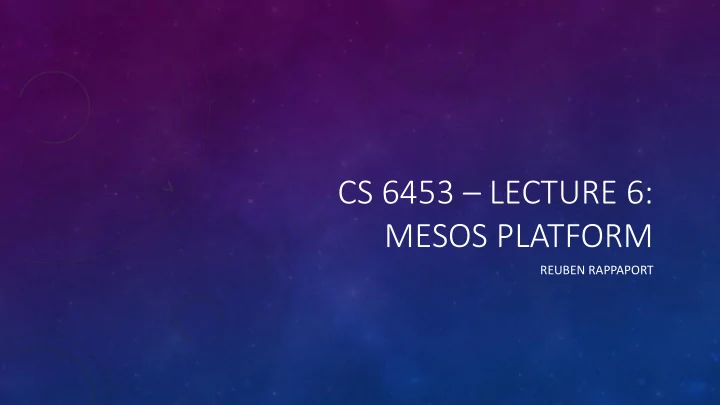

CS 6453 – LECTURE 6: MESOS PLATFORM REUBEN RAPPAPORT
WHAT IS THE PROBLEM? • There are many existing frameworks for cluster computing • Generally, different frameworks are best for each application • Obvious problem: How to share cluster between frameworks • Static Partition • Allocate VMs on a per framework basis • None of these perform well with fine grained tasks
MESOS PLATFORM • Thin resource sharing layer • Allows multiple cluster frameworks to run simultaneously • Provides common interface for all frameworks to access resources • Decentralized scheduler • Works on resource offer model • Mesos decides how many resources to offer each framework • Frameworks decide which offered resources to use for what
WHY IS IT INTERESTING? • Resource sharing allows for new and exciting cluster configurations • Can run multiple instances of same framework on different workloads as an experiment • Much easier to write specialized frameworks that only solve a single problem
RELATED WORK • High Performance Computing has a large literature on cluster management • Optimized for setup with course grained monolithic jobs • Designed for specific specialized hardware • Cloud computing services (eg EC2) • VM level abstraction is much more course grained than Mesos • No ability to specify placement needs • Fair usage of cache by multiple users with shared files (FairRide) • Fair allocation of network resources in cloud computing (FairCloud) • Many cluster management frameworks contain their own frameworks (Quincy, Condor, etc)
MESOS MODEL • Mesos master consists of pluggable allocator • Decides how to assign resource offers • Other masters run on standby for fault tolerance • Master consists of soft state only – it’s entirely reconstructable from the schedulers and slaves
MESOS MODEL • Frameworks consist of two components • Schedulers accept or reject resource offers and decide which tasks to run where • Slaves actually run tasks and report their status to the allocator • Slaves are isolated using containers
SCALABILITY • To avoid sending unnecessary resource offers Mesos allows schedulers to specify filters • Boolean predicate resource offer must satisfy in order to be sent in the first place • Scheduler is still free to reject or accept tasks which satisfy it • Mesos allows schedulers to create duplicates of themselves running on standby • When the master scheduler fails it is replaced by one of these
DEALING WITH WAYWARD SCHEDULERS • Schedulers are assigned a guaranteed allocation • When they are under this limit their tasks are safe • If they go over it then the allocator reserves the right to kill their tasks if needed • Until an offer has been rejected, Mesos counts it towards the scheduler it was sent to’s total allocation • This incentivizes quick offer processing • If a scheduler takes too long to reply to an offer Mesos will rescind it
EVALUATION SETUP • Comparison of running workloads on Mesos vs running them with static partitioning • Four workloads • Hadoop mix based off Facebook workload dataset • Large Hadoop mix emulating batch workload • Spark machine learning job • Torque/MPI raytracing job
EVALUATION RESULTS • Mesos scales resource allocation as demand changes • Much better utilization than static partitioning • Ability to scale up in short bursts when demand allows it improves performance
EVALUATION RESULTS • Utilization results much better than static partitioning overall • Mesos shows a stronger improvement for memory utilization than for CPU • This is likely due to its strong focus on data locality in assigning fine grained tasks
EVALUATION RESULTS • Mesos allows CPU share to scale with demand as the relative needs change • Fine grained task allocation makes adjusting to changes rapid
EVALUATION RESULTS • The tachyon ray tracing job is the only one which performed worse on Mesos than on the static partition • This is likely a result of the job’s long task times and strong interdependency – it runs as slowly as the slowest node so stragglers drag it down • Overall the Mesos platform imposes about a 4% overhead • In a separate scalability experiment Mesos ran on a 50,000 node system without imposing a significant additional overhead
DOWNSIDES • Mesos works best when jobs are shortlived and small relative to the size of the cluster • Individual frameworks don’t have enough knowledge to implement preemption or policies that require views of the whole cluster • Frameworks trying to implement gang scheduling will be incentivized to hoard resources, possibly resulting in deadlock until the allocator begins to forcibly terminate tasks
GOING FORWARD • Possible future experiments • Run several instances of the same framework side by side and compare their performance on differing workloads • Characterize the effect that frameworks with certain characteristics have on other frameworks running on the cluster – do greedy frameworks starve more timid ones?
GOING FORWARD • Holy grail in this space would be a decentralized scheduler that can perform just as well as a central one • Mesos does a reasonable job of approximating it but falls fall short of optimality and incurs an overhead (albeit not a large one) • Probably not achievable – the best we can do is try to build better and better approximations
Recommend
More recommend